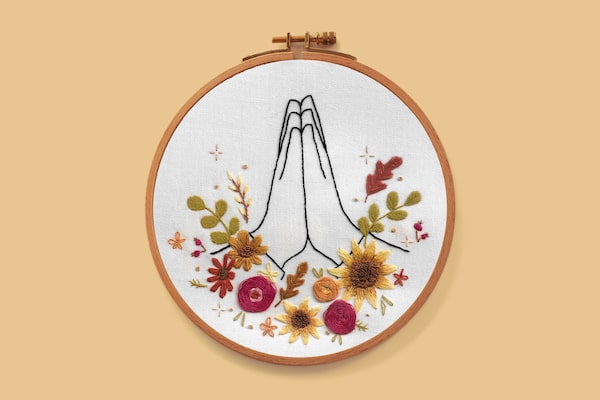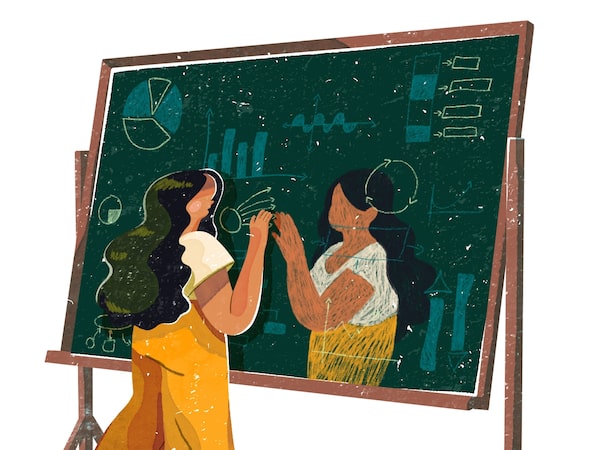This is the weekly Amplify newsletter. If you’re reading this on the web or someone forwarded this e-mail newsletter to you, you can sign up for Amplify and all Globe newsletters here.
A great illustration has the power to move you. It tells a story. Sets a mood. Provokes. Intrigues. Shifts your thinking.
As executive editor at The Globe and Mail, I see first hand how much thought goes into how to best visualize what’s happening in our world. And this year, a year like no other, illustrations played a particularly important role, capturing our varying moods and roller coaster emotions.
For this issue of Amplify, I wanted to highlight some of my favourite illustrations of 2020 by female artists.
Hanna Barczyk has been illustrating Elizabeth Renzetti’s columns for years. Week after week, we continue to be impressed with Barcyzk’s ability to distill complex ideas into striking visuals that are highly relatable. And this year was no different. I was particularly struck by how she captured Dolly Parton in this recent column, how she normalized our topsy turvy emotions or the extra danger coronavirus lockdowns put on women in abusive relationships.

JooHee Yoon's illustration perfectly captures the wonder and awe of a newfound bird-watching hobby.Illustration by JooHee Yoon
When I first saw this bird illustration for the cover of our Opinion section, I gasped. JooHee Yoon perfectly captured the wonder and awe of my new-found bird watching hobby. There I was in her drawing, looking out the window.
I’ve got a couple of feeders in my tiny Toronto backyard, which attract an array of birds including cardinals, finches, blue jays and woodpeckers. In the Before Time, I was never home during the day to enjoy them so it was a delight to watch the little birds from my makeshift home office as spring lockdown turned to summer. My poor colleagues had to endure frequent play-by-plays of a fat woodpecker who refused to share the feeder ledge with chickadees.
The illustration’s vibrant colours and sketch-like qualities are energetic, but very deliberate. Yoon simultaneously conveyed hopefulness for the future and nostalgia.

Salini Perera's work was featured in our Pandemic Summer series, where Globe reporter Ian Brown explored everything from a physically-distanced canoe trip to crashing at a friend's cottage.Illustration by Salini Perera
Salini Perera has done some really beautiful work for us including a striking cover for our best books of the year, The Globe 100. Her use of colour injects a lively energy into her work and I am immediately transported to that bookstore window.
Born in Sri Lanka, raised in Scarborough, Ont., Perera also illustrated a summer series written by Ian Brown about the ways Canadians tried to reclaim their lives after the first lockdown. From the chance to jump in a pool to crashing a friend’s cottage and a physically distanced canoe trip, Perera’s colour palettes, along with her fine lines, bring a playful yet sophisticated tone – the perfect complement to Brown’s lighthearted yet contemplative COVID-19 stories.
Earlier in the pandemic Perera created a more sombre work for us, illustrating the sudden strain front-line workers were under.
Speaking of strain, I think it’s fair to say we are all under strain when it comes to being separated from our families and friends. We had a long chat at one of our weekly weekend cover meetings about how to best depict Thanksgiving, a holiday where many of us were told to celebrate via Zoom. One of the main pieces that weekend was an essay by Erin Anderssen on the science behind showing gratitude.

Emily Beaton's illustration of embroidered hands perfectly depicted our story on gratitude and giving thanks.Illustration by Emily beaton
We settled on embroidery because it is often used in home decor items (think cushions, dish towels, artwork). We had Toronto artist Emily Beaton focus on the hands icon, a recognized symbol of thankfulness. We also asked her to send scans of her needle and thread work to create a gif. We hope the work-in-progress showed how cultivating true gratitude is itself a work in progress.
Beaton’s carefully executed stitch work, which required an exceptional amount of patience and thoughtfulness, parallels the sentiments of Anderssen’s essay on gratitude perfectly.

Kathleen Fu's sharp eye gave our Future of Cities illustrations a life of their own.The Globe and Mail
A few weeks later when we were preparing our series on the future of cities, Kathleen Fu was our first choice to illustrate. Her intricate illustrations are a marvel. As I spent time with her work, my eyes found more and more vignettes, each with its own little narrative. I was not surprised to learn she’s currently studying for a master of architecture at the University of Waterloo in Ontario.
Equally as mesmerizing but very different stylistically is the work of Chief Lady Bird. Portrait illustration, an art she has mastered, can be a particularly challenging task. We spend our entire lives, from the day we are born, interpreting faces and people’s body language. So, when an artist like Chief Lady Bird is able to capture both the likeness of a person and their personality on paper, it speaks volumes.
I love Chief Lady Bird’s style: the aesthetic is confident and bold, which perfectly matches the leaders we have been profiling in our bi-weekly Indigenous leadership series. They include executive vice-president of National Bank Financial Sean St. John and Aboriginal Peoples Television Network CEO Monika Ille.
Illustrating our beloved First Person essays can be a challenge. The artist is tasked with visualizing a writer’s intimate revelations. Choosing the right moment, metaphor or scene to illustrate demands both a leap of faith and a deep dive into someone’s psyche.
I often want to climb inside the worlds Rachel Wada creates. The Vancouver artist describes her style as an amalgamation of cultural influences and techniques that reflect her Japanese-Chinese heritage. To me, they evoke both strength and tenderness as in this piece about racial identity or this one, in which a mother struggles with how to talk to her university-aged daughter.

Rachel Wada's illustrations capture the intimate nature of our First Person essays, as this one did in an essay about racial identify.Illustration by Rachel Wada
Other First Person art that moved me: Vancouver artist Chelsea O’Byrne’s depiction of a mom cutting out newspaper clippings to mail to her daughter (the shades of red underscore the heartwarming tone of the piece) and Toronto illustrator Wenting Li’s livestock in this piece about emotional-support chickens (yes, chickens).
Combined, these illustrations encapsulate the year for me; a year where my emotions bounced left, right, up and down. If art galleries are looking for future exhibit ideas to capture the COVID-19 experience, may I suggest some of the aforementioned work be blown up and hung on walls so I can wander among them, glass of red wine in hand. Maybe once this is all over.
What else we’re thinking about:
I am still thinking about this piece by Globe reporter Zosia Bielski we published a few weeks ago. Probably because my daughter recently turned 13 and my mind can’t help but think ahead to a future where she’s going to be dating. Bielski describes a class for Grade 11 and 12 girls that sounds nothing like my sex-education experience (we awkwardly talked about body parts and then quickly moved to the safer subject of nutrition). It brings me great hope that future high schoolers might learn about mental and physical safety, assertiveness and how to spot the red flags of sexually coercive behaviour before they go to university. What parent doesn’t want to shield their daughter from that? As much as I don’t want to think about my kid being sexually active, it’s going to happen so let’s teach what desire and pleasure mean. Wish I had these conversations growing up.
Inspired by something in this newsletter? If so, we hope you’ll amplify it by passing it on. And if there’s something we should know, or feedback you’d like to share, send us an e-mail at amplify@globeandmail.com.